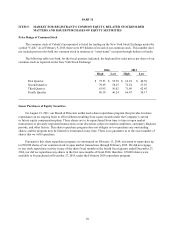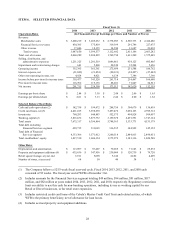Cabela's 2014 Annual Report Download - page 30
Download and view the complete annual report
Please find page 30 of the 2014 Cabela's annual report below. You can navigate through the pages in the report by either clicking on the pages listed below, or by using the keyword search tool below to find specific information within the annual report.20
the Basel III liquidity requirements. These changes could delay or disrupt access to funding under the variable
funding facilities. Moreover, the liquidity requirements under Basel III could result in an increase in the borrowing
costs under the variable funding facilities.
Furthermore, even if we are able to securitize our credit card loans consistent with past practice, poor
performance of our loans, including increased delinquencies and credit losses, lower payment rates, or a decrease
in excess spreads below certain thresholds, could result in a downgrade or withdrawal of the ratings on the
outstanding securities issued in our securitization transactions, cause “early amortization” or “early redemption”
of these securities, or result in higher required credit enhancement levels. This could jeopardize our ability to
complete other securitization transactions on acceptable terms, decrease our liquidity, and force us to rely on other
potentially more expensive funding sources, to the extent available, which would decrease our profitability.
Our current funding strategy also includes a continued reliance on certificates of deposit to help fund growth
and maturing securitizations. If there is an increase in other financial institutions relying on the certificates of
deposit market for liquidity and funding, competition in the deposits market may increase. In addition, FDIC
deposit insurance coverage may be reduced. Either of these events could result in less funds available or funds
at unattractive rates. In addition to the non-brokered certificates of deposit market to fund growth and maturing
securitizations, we have access to the brokered certificates of deposit market through multiple financial institutions
for liquidity and funding purposes. Our ability to issue certificates of deposit is reliant on our current regulatory
capital levels. If WFB were to be classified as an “adequately-capitalized” bank, we would be required to obtain
a waiver from the FDIC in order to continue to issue certificates of deposit and would be limited to what interest
rate we can pay on deposits. At the end of 2014, WFB met the requirements for a “well-capitalized” institution, the
highest of the Federal Deposit Insurance Corporation Improvement Act’s five capital ratio levels.
We may have to reallocate capital from our Retail and Direct businesses to meet the capital needs of
our Financial Services segment, which could alter our retail store expansion program.
WFB must satisfy the capital maintenance requirements of government regulators and its agreement with
Visa U.S.A., Inc. (“Visa”). At the end of 2014, WFB was classified as a “well-capitalized” bank, the highest
category under the regulatory framework for prompt corrective action. Although WFB satisfied the requirements
for the “well-capitalized” classification at the end of 2014, no assurances can be given that WFB will continue to
satisfy such requirements. A variety of factors could cause the capital requirements of WFB to exceed our ability
to generate capital internally or from third party sources. For example, government regulators or Visa could
unilaterally increase their minimum capital requirements. On July 9, 2013, the FDIC adopted interim final rules
which revise its risk-based and leverage capital requirements for FDIC-supervised institutions. These interim final
rules are substantially identical to the joint final rules issued by the Office of the Comptroller of the Currency
and the Board of Governors of the Federal Reserve System on July 2, 2013. The interim final rules and the joint
final rules implement the regulatory capital reforms recommended by Basel III, and capital reforms required by
the Dodd-Frank Wall Street Reform and Consumer Protection Act (the “Reform Act”). Among other things, the
interim final rules and the joint final rules revise the agencies’ prompt corrective action framework by introducing
a common equity tier 1 capital requirement and a higher minimum tier 1 capital requirement. In addition, the
interim final rules and the joint final rules include a supplementary leverage ratio for depository institutions subject
to the advanced approaches capital rules. The phase-in period for the interim final rules began in January 2015 for
WFB. Also, we have significant potential obligations in the form of the unused credit lines of our cardholders. At
the end of 2014, these unfunded amounts totaled approximately $30 billion. Draws on these lines of credit could
materially exceed predicted line usage. If WFB ceases to qualify as well-capitalized, WFB would become subject
to regulatory restrictions that could materially adversely affect its liquidity, cost of funds, and ability to conduct
normal operations. If WFB’s capital requirements were to increase, we may have to contribute capital to WFB,
which may require us to raise additional debt or equity capital and/or divert capital from our Retail and Direct
businesses, which in turn could significantly alter our retail store expansion strategy.
























